University Taxation Report: Smith's Tax Implications and Analysis
VerifiedAdded on 2020/02/24
|12
|2946
|228
Report
AI Summary
This report provides a comprehensive analysis of Smith's tax liabilities, focusing on his residential status, income from primary production, and capital gains tax consequences. It examines the application of Australian tax laws, including the Income Tax Assessment Act 1997 and 1936, to determine Smith's tax obligations. The report explores the domicile test, the 183-day rule, and the ordinary concept of residency to establish Smith's residential status. It further analyzes Smith's income from primary production, specifically the growing of olive trees and the subsequent oil production, considering the relevant taxation rulings. The report also addresses the capital gains tax implications of subdividing land used for primary production. The analysis includes references to relevant case law and taxation rulings to support the conclusions regarding Smith's tax liabilities. The report concludes that Smith is a resident of Australia for tax purposes and provides insights into his income and capital gains tax obligations.
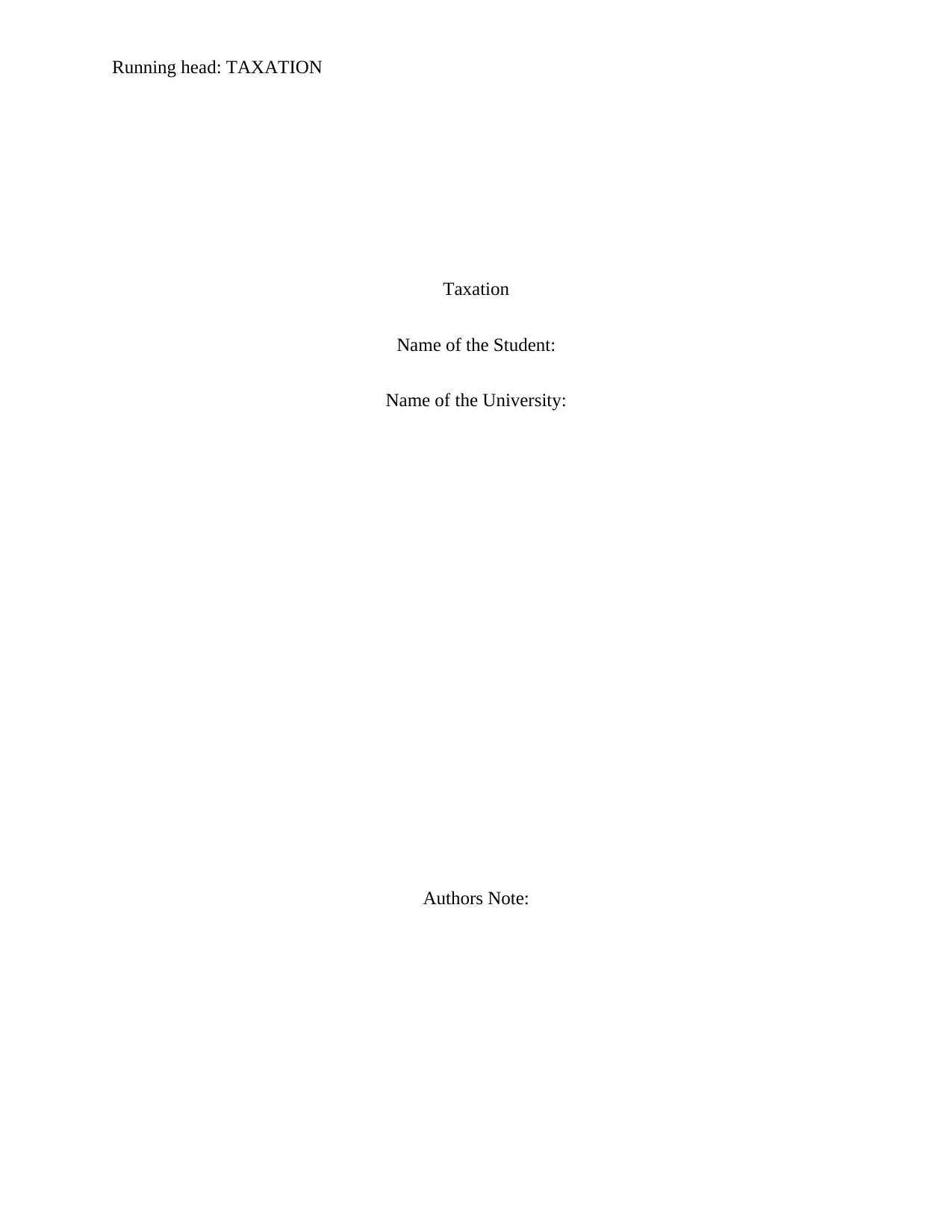
Running head: TAXATION
Taxation
Name of the Student:
Name of the University:
Authors Note:
Taxation
Name of the Student:
Name of the University:
Authors Note:
Paraphrase This Document
Need a fresh take? Get an instant paraphrase of this document with our AI Paraphraser
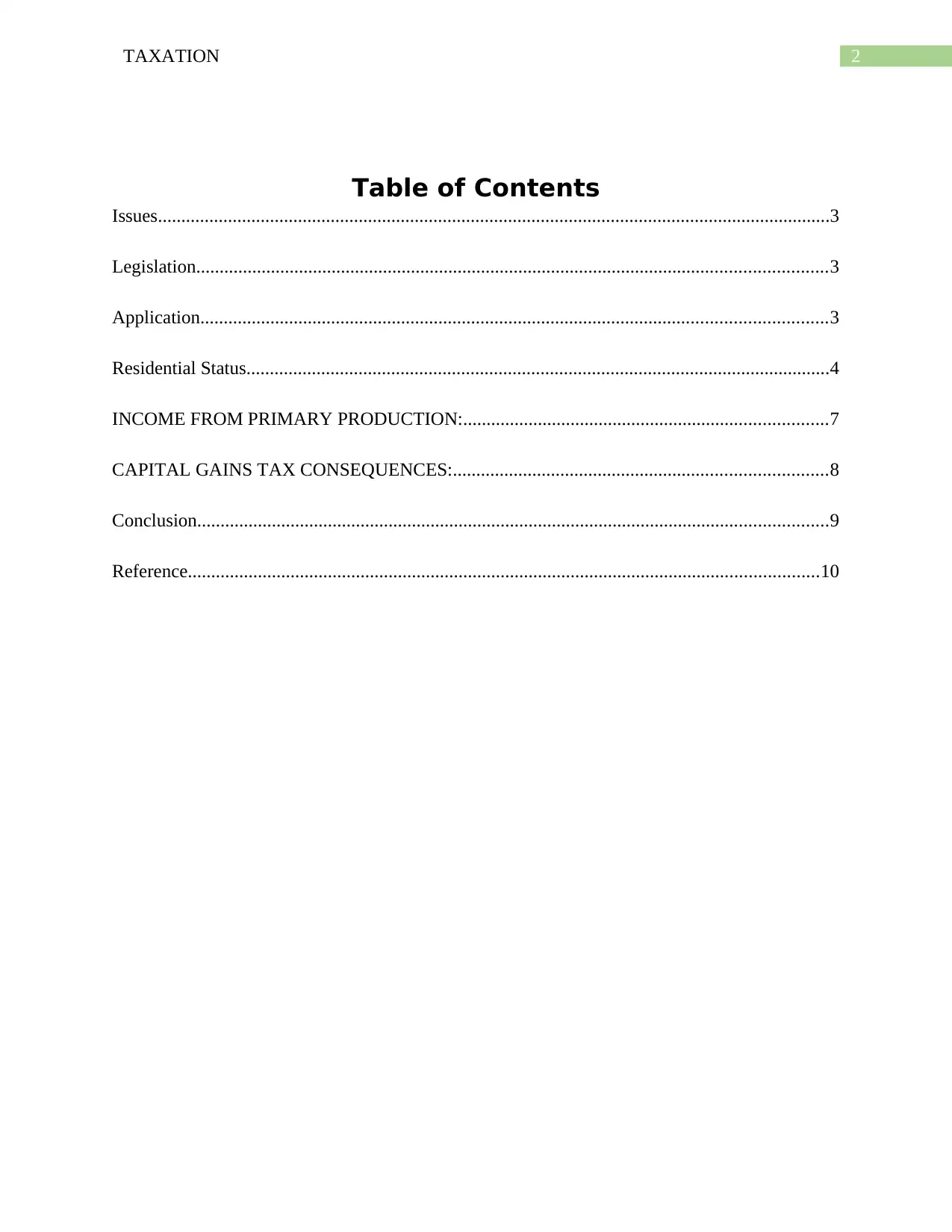
2TAXATION
Table of Contents
Issues................................................................................................................................................3
Legislation.......................................................................................................................................3
Application......................................................................................................................................3
Residential Status.............................................................................................................................4
INCOME FROM PRIMARY PRODUCTION:..............................................................................7
CAPITAL GAINS TAX CONSEQUENCES:................................................................................8
Conclusion.......................................................................................................................................9
Reference.......................................................................................................................................10
Table of Contents
Issues................................................................................................................................................3
Legislation.......................................................................................................................................3
Application......................................................................................................................................3
Residential Status.............................................................................................................................4
INCOME FROM PRIMARY PRODUCTION:..............................................................................7
CAPITAL GAINS TAX CONSEQUENCES:................................................................................8
Conclusion.......................................................................................................................................9
Reference.......................................................................................................................................10
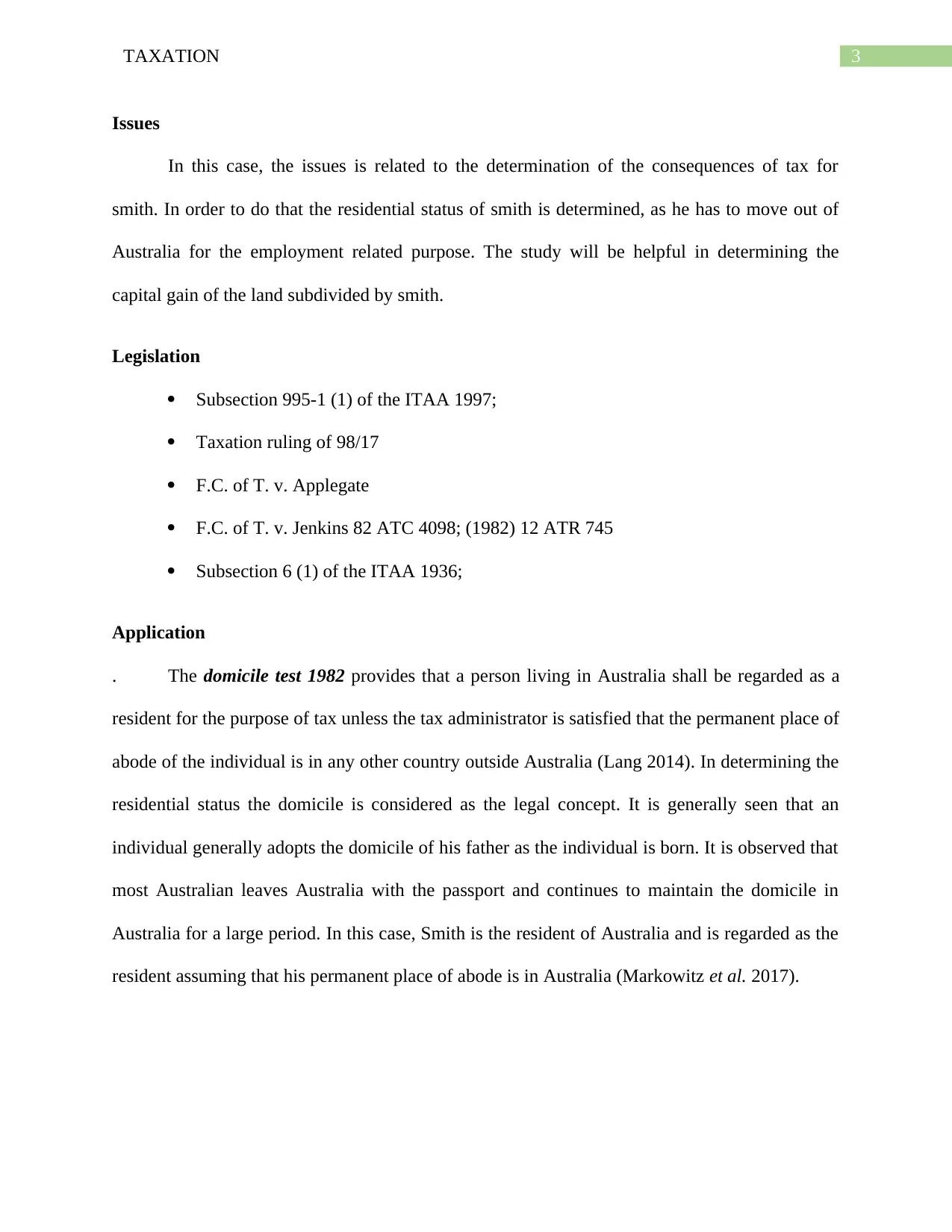
3TAXATION
Issues
In this case, the issues is related to the determination of the consequences of tax for
smith. In order to do that the residential status of smith is determined, as he has to move out of
Australia for the employment related purpose. The study will be helpful in determining the
capital gain of the land subdivided by smith.
Legislation
Subsection 995-1 (1) of the ITAA 1997;
Taxation ruling of 98/17
F.C. of T. v. Applegate
F.C. of T. v. Jenkins 82 ATC 4098; (1982) 12 ATR 745
Subsection 6 (1) of the ITAA 1936;
Application
. The domicile test 1982 provides that a person living in Australia shall be regarded as a
resident for the purpose of tax unless the tax administrator is satisfied that the permanent place of
abode of the individual is in any other country outside Australia (Lang 2014). In determining the
residential status the domicile is considered as the legal concept. It is generally seen that an
individual generally adopts the domicile of his father as the individual is born. It is observed that
most Australian leaves Australia with the passport and continues to maintain the domicile in
Australia for a large period. In this case, Smith is the resident of Australia and is regarded as the
resident assuming that his permanent place of abode is in Australia (Markowitz et al. 2017).
Issues
In this case, the issues is related to the determination of the consequences of tax for
smith. In order to do that the residential status of smith is determined, as he has to move out of
Australia for the employment related purpose. The study will be helpful in determining the
capital gain of the land subdivided by smith.
Legislation
Subsection 995-1 (1) of the ITAA 1997;
Taxation ruling of 98/17
F.C. of T. v. Applegate
F.C. of T. v. Jenkins 82 ATC 4098; (1982) 12 ATR 745
Subsection 6 (1) of the ITAA 1936;
Application
. The domicile test 1982 provides that a person living in Australia shall be regarded as a
resident for the purpose of tax unless the tax administrator is satisfied that the permanent place of
abode of the individual is in any other country outside Australia (Lang 2014). In determining the
residential status the domicile is considered as the legal concept. It is generally seen that an
individual generally adopts the domicile of his father as the individual is born. It is observed that
most Australian leaves Australia with the passport and continues to maintain the domicile in
Australia for a large period. In this case, Smith is the resident of Australia and is regarded as the
resident assuming that his permanent place of abode is in Australia (Markowitz et al. 2017).
⊘ This is a preview!⊘
Do you want full access?
Subscribe today to unlock all pages.

Trusted by 1+ million students worldwide
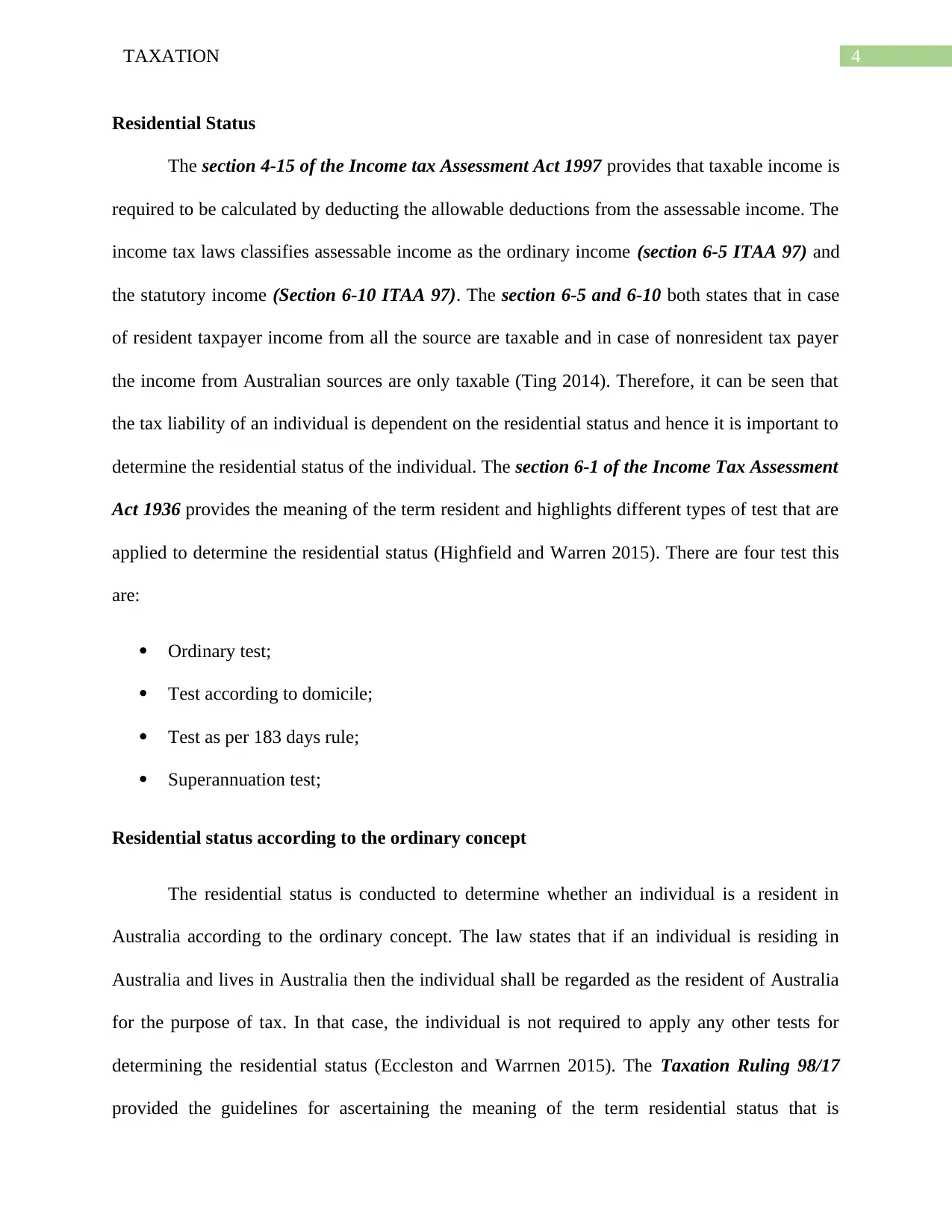
4TAXATION
Residential Status
The section 4-15 of the Income tax Assessment Act 1997 provides that taxable income is
required to be calculated by deducting the allowable deductions from the assessable income. The
income tax laws classifies assessable income as the ordinary income (section 6-5 ITAA 97) and
the statutory income (Section 6-10 ITAA 97). The section 6-5 and 6-10 both states that in case
of resident taxpayer income from all the source are taxable and in case of nonresident tax payer
the income from Australian sources are only taxable (Ting 2014). Therefore, it can be seen that
the tax liability of an individual is dependent on the residential status and hence it is important to
determine the residential status of the individual. The section 6-1 of the Income Tax Assessment
Act 1936 provides the meaning of the term resident and highlights different types of test that are
applied to determine the residential status (Highfield and Warren 2015). There are four test this
are:
Ordinary test;
Test according to domicile;
Test as per 183 days rule;
Superannuation test;
Residential status according to the ordinary concept
The residential status is conducted to determine whether an individual is a resident in
Australia according to the ordinary concept. The law states that if an individual is residing in
Australia and lives in Australia then the individual shall be regarded as the resident of Australia
for the purpose of tax. In that case, the individual is not required to apply any other tests for
determining the residential status (Eccleston and Warrnen 2015). The Taxation Ruling 98/17
provided the guidelines for ascertaining the meaning of the term residential status that is
Residential Status
The section 4-15 of the Income tax Assessment Act 1997 provides that taxable income is
required to be calculated by deducting the allowable deductions from the assessable income. The
income tax laws classifies assessable income as the ordinary income (section 6-5 ITAA 97) and
the statutory income (Section 6-10 ITAA 97). The section 6-5 and 6-10 both states that in case
of resident taxpayer income from all the source are taxable and in case of nonresident tax payer
the income from Australian sources are only taxable (Ting 2014). Therefore, it can be seen that
the tax liability of an individual is dependent on the residential status and hence it is important to
determine the residential status of the individual. The section 6-1 of the Income Tax Assessment
Act 1936 provides the meaning of the term resident and highlights different types of test that are
applied to determine the residential status (Highfield and Warren 2015). There are four test this
are:
Ordinary test;
Test according to domicile;
Test as per 183 days rule;
Superannuation test;
Residential status according to the ordinary concept
The residential status is conducted to determine whether an individual is a resident in
Australia according to the ordinary concept. The law states that if an individual is residing in
Australia and lives in Australia then the individual shall be regarded as the resident of Australia
for the purpose of tax. In that case, the individual is not required to apply any other tests for
determining the residential status (Eccleston and Warrnen 2015). The Taxation Ruling 98/17
provided the guidelines for ascertaining the meaning of the term residential status that is
Paraphrase This Document
Need a fresh take? Get an instant paraphrase of this document with our AI Paraphraser
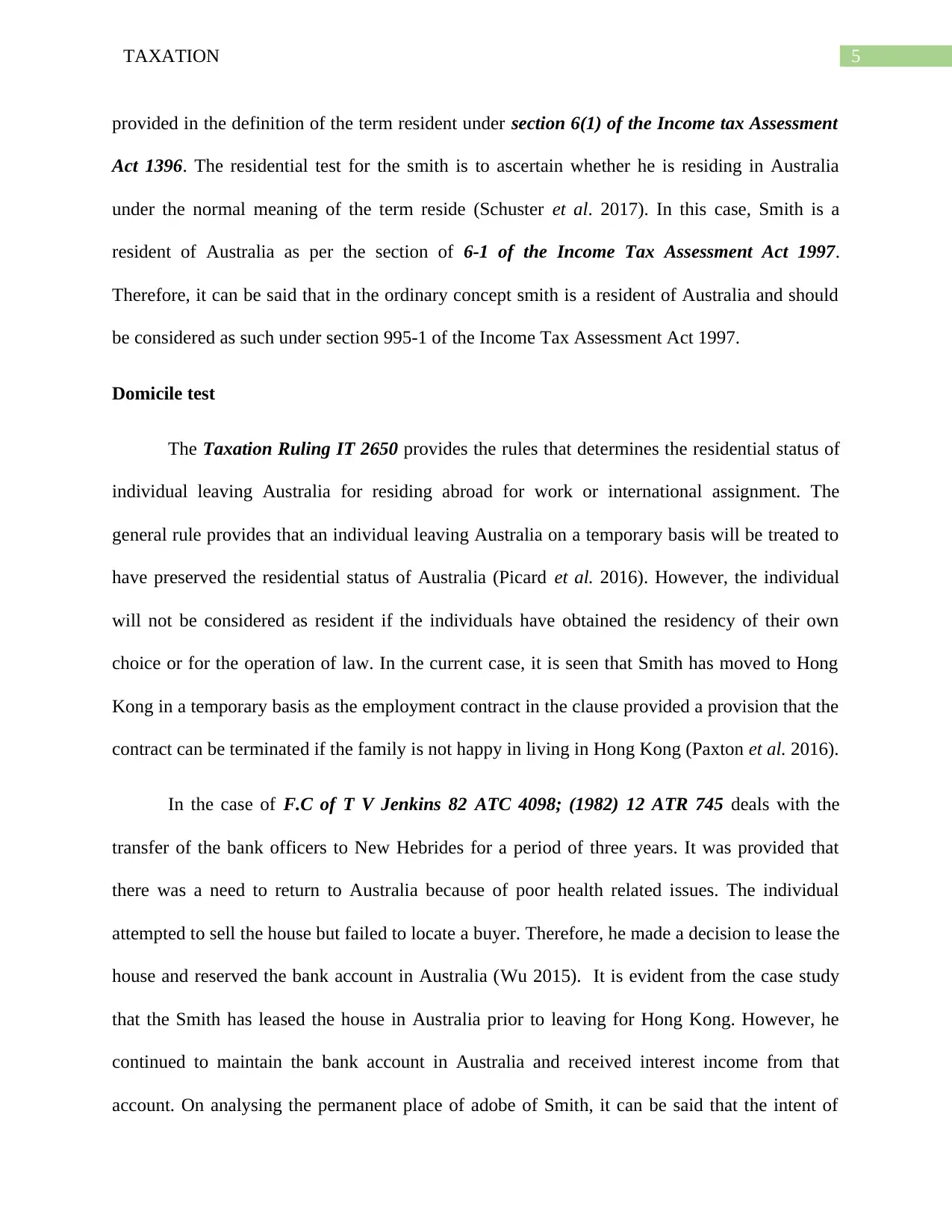
5TAXATION
provided in the definition of the term resident under section 6(1) of the Income tax Assessment
Act 1396. The residential test for the smith is to ascertain whether he is residing in Australia
under the normal meaning of the term reside (Schuster et al. 2017). In this case, Smith is a
resident of Australia as per the section of 6-1 of the Income Tax Assessment Act 1997.
Therefore, it can be said that in the ordinary concept smith is a resident of Australia and should
be considered as such under section 995-1 of the Income Tax Assessment Act 1997.
Domicile test
The Taxation Ruling IT 2650 provides the rules that determines the residential status of
individual leaving Australia for residing abroad for work or international assignment. The
general rule provides that an individual leaving Australia on a temporary basis will be treated to
have preserved the residential status of Australia (Picard et al. 2016). However, the individual
will not be considered as resident if the individuals have obtained the residency of their own
choice or for the operation of law. In the current case, it is seen that Smith has moved to Hong
Kong in a temporary basis as the employment contract in the clause provided a provision that the
contract can be terminated if the family is not happy in living in Hong Kong (Paxton et al. 2016).
In the case of F.C of T V Jenkins 82 ATC 4098; (1982) 12 ATR 745 deals with the
transfer of the bank officers to New Hebrides for a period of three years. It was provided that
there was a need to return to Australia because of poor health related issues. The individual
attempted to sell the house but failed to locate a buyer. Therefore, he made a decision to lease the
house and reserved the bank account in Australia (Wu 2015). It is evident from the case study
that the Smith has leased the house in Australia prior to leaving for Hong Kong. However, he
continued to maintain the bank account in Australia and received interest income from that
account. On analysing the permanent place of adobe of Smith, it can be said that the intent of
provided in the definition of the term resident under section 6(1) of the Income tax Assessment
Act 1396. The residential test for the smith is to ascertain whether he is residing in Australia
under the normal meaning of the term reside (Schuster et al. 2017). In this case, Smith is a
resident of Australia as per the section of 6-1 of the Income Tax Assessment Act 1997.
Therefore, it can be said that in the ordinary concept smith is a resident of Australia and should
be considered as such under section 995-1 of the Income Tax Assessment Act 1997.
Domicile test
The Taxation Ruling IT 2650 provides the rules that determines the residential status of
individual leaving Australia for residing abroad for work or international assignment. The
general rule provides that an individual leaving Australia on a temporary basis will be treated to
have preserved the residential status of Australia (Picard et al. 2016). However, the individual
will not be considered as resident if the individuals have obtained the residency of their own
choice or for the operation of law. In the current case, it is seen that Smith has moved to Hong
Kong in a temporary basis as the employment contract in the clause provided a provision that the
contract can be terminated if the family is not happy in living in Hong Kong (Paxton et al. 2016).
In the case of F.C of T V Jenkins 82 ATC 4098; (1982) 12 ATR 745 deals with the
transfer of the bank officers to New Hebrides for a period of three years. It was provided that
there was a need to return to Australia because of poor health related issues. The individual
attempted to sell the house but failed to locate a buyer. Therefore, he made a decision to lease the
house and reserved the bank account in Australia (Wu 2015). It is evident from the case study
that the Smith has leased the house in Australia prior to leaving for Hong Kong. However, he
continued to maintain the bank account in Australia and received interest income from that
account. On analysing the permanent place of adobe of Smith, it can be said that the intent of
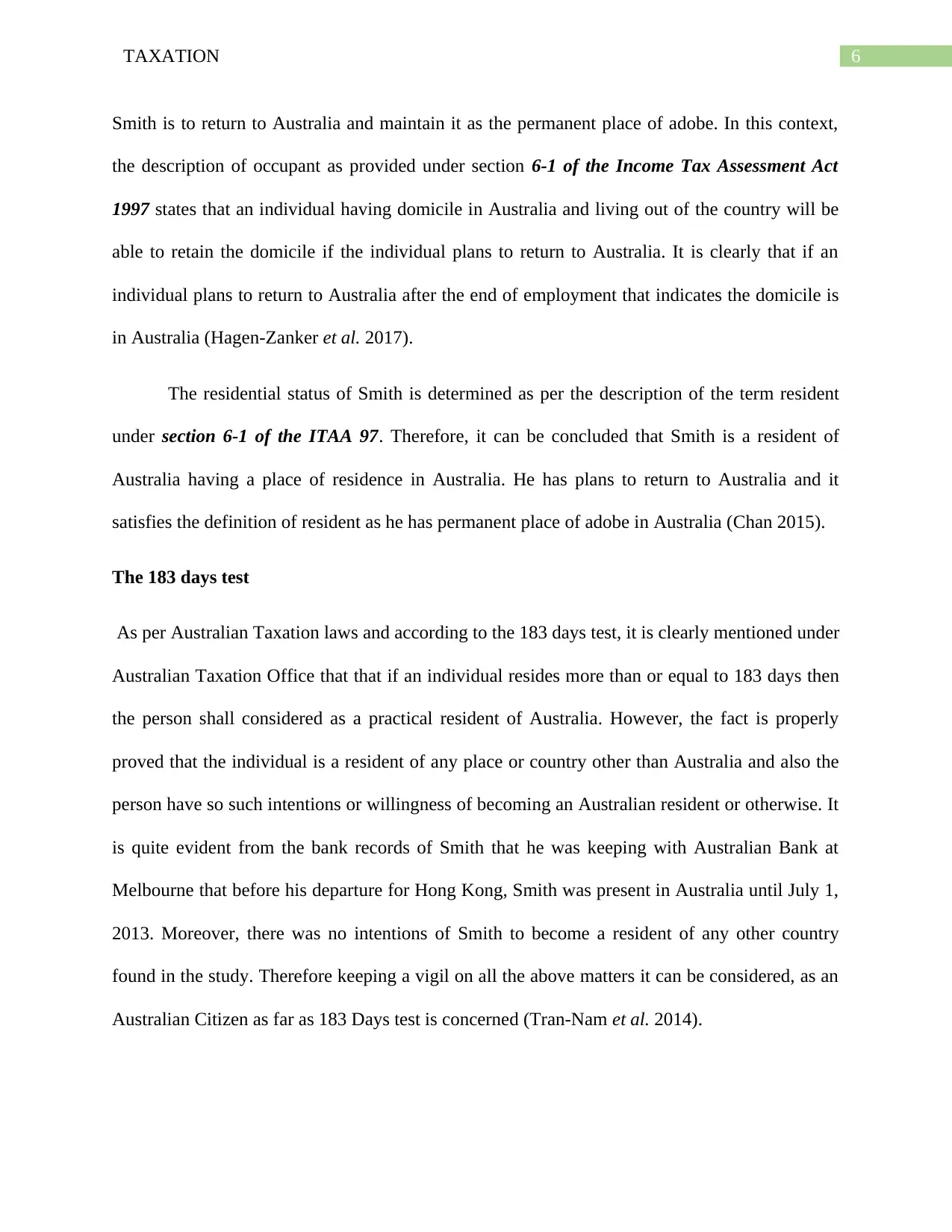
6TAXATION
Smith is to return to Australia and maintain it as the permanent place of adobe. In this context,
the description of occupant as provided under section 6-1 of the Income Tax Assessment Act
1997 states that an individual having domicile in Australia and living out of the country will be
able to retain the domicile if the individual plans to return to Australia. It is clearly that if an
individual plans to return to Australia after the end of employment that indicates the domicile is
in Australia (Hagen-Zanker et al. 2017).
The residential status of Smith is determined as per the description of the term resident
under section 6-1 of the ITAA 97. Therefore, it can be concluded that Smith is a resident of
Australia having a place of residence in Australia. He has plans to return to Australia and it
satisfies the definition of resident as he has permanent place of adobe in Australia (Chan 2015).
The 183 days test
As per Australian Taxation laws and according to the 183 days test, it is clearly mentioned under
Australian Taxation Office that that if an individual resides more than or equal to 183 days then
the person shall considered as a practical resident of Australia. However, the fact is properly
proved that the individual is a resident of any place or country other than Australia and also the
person have so such intentions or willingness of becoming an Australian resident or otherwise. It
is quite evident from the bank records of Smith that he was keeping with Australian Bank at
Melbourne that before his departure for Hong Kong, Smith was present in Australia until July 1,
2013. Moreover, there was no intentions of Smith to become a resident of any other country
found in the study. Therefore keeping a vigil on all the above matters it can be considered, as an
Australian Citizen as far as 183 Days test is concerned (Tran-Nam et al. 2014).
Smith is to return to Australia and maintain it as the permanent place of adobe. In this context,
the description of occupant as provided under section 6-1 of the Income Tax Assessment Act
1997 states that an individual having domicile in Australia and living out of the country will be
able to retain the domicile if the individual plans to return to Australia. It is clearly that if an
individual plans to return to Australia after the end of employment that indicates the domicile is
in Australia (Hagen-Zanker et al. 2017).
The residential status of Smith is determined as per the description of the term resident
under section 6-1 of the ITAA 97. Therefore, it can be concluded that Smith is a resident of
Australia having a place of residence in Australia. He has plans to return to Australia and it
satisfies the definition of resident as he has permanent place of adobe in Australia (Chan 2015).
The 183 days test
As per Australian Taxation laws and according to the 183 days test, it is clearly mentioned under
Australian Taxation Office that that if an individual resides more than or equal to 183 days then
the person shall considered as a practical resident of Australia. However, the fact is properly
proved that the individual is a resident of any place or country other than Australia and also the
person have so such intentions or willingness of becoming an Australian resident or otherwise. It
is quite evident from the bank records of Smith that he was keeping with Australian Bank at
Melbourne that before his departure for Hong Kong, Smith was present in Australia until July 1,
2013. Moreover, there was no intentions of Smith to become a resident of any other country
found in the study. Therefore keeping a vigil on all the above matters it can be considered, as an
Australian Citizen as far as 183 Days test is concerned (Tran-Nam et al. 2014).
⊘ This is a preview!⊘
Do you want full access?
Subscribe today to unlock all pages.

Trusted by 1+ million students worldwide
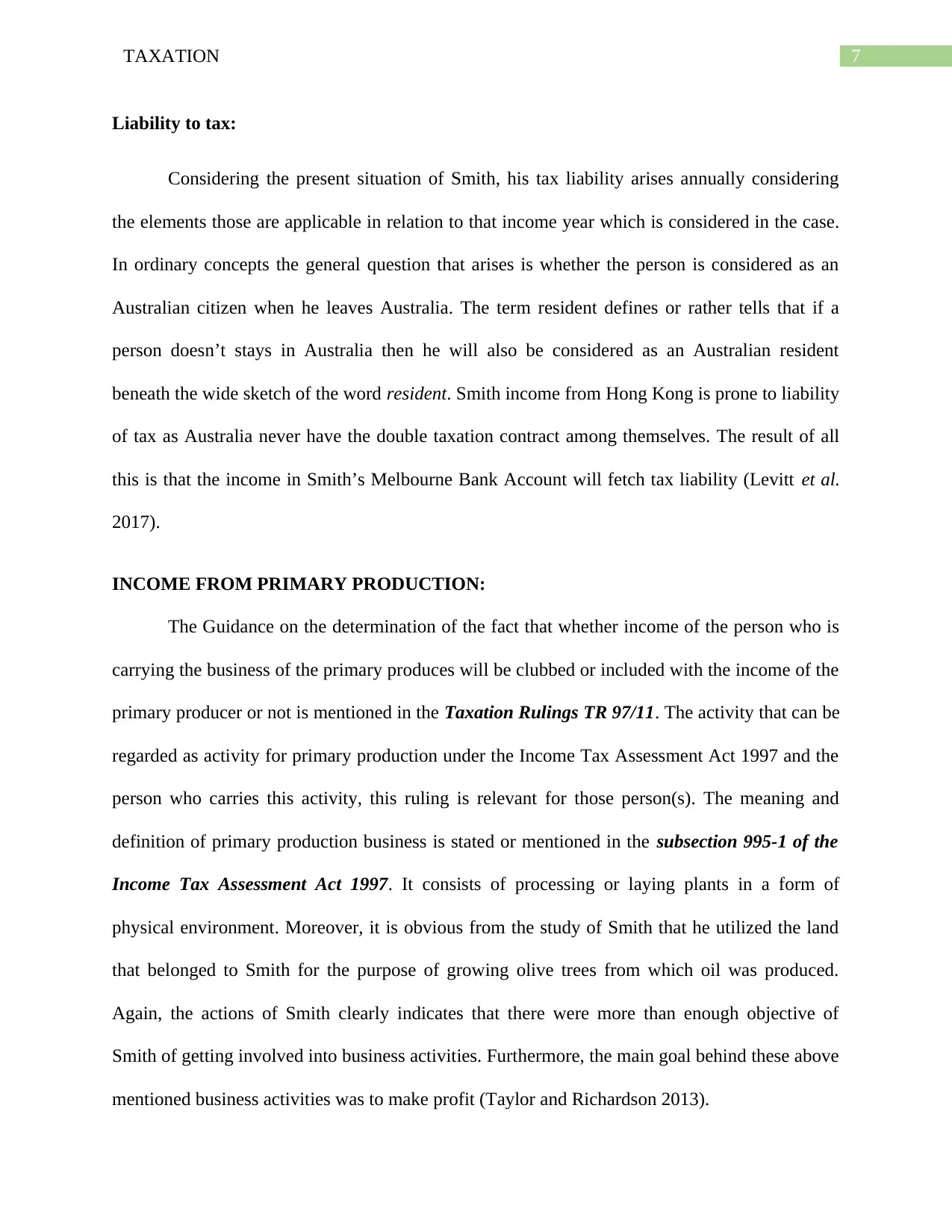
7TAXATION
Liability to tax:
Considering the present situation of Smith, his tax liability arises annually considering
the elements those are applicable in relation to that income year which is considered in the case.
In ordinary concepts the general question that arises is whether the person is considered as an
Australian citizen when he leaves Australia. The term resident defines or rather tells that if a
person doesn’t stays in Australia then he will also be considered as an Australian resident
beneath the wide sketch of the word resident. Smith income from Hong Kong is prone to liability
of tax as Australia never have the double taxation contract among themselves. The result of all
this is that the income in Smith’s Melbourne Bank Account will fetch tax liability (Levitt et al.
2017).
INCOME FROM PRIMARY PRODUCTION:
The Guidance on the determination of the fact that whether income of the person who is
carrying the business of the primary produces will be clubbed or included with the income of the
primary producer or not is mentioned in the Taxation Rulings TR 97/11. The activity that can be
regarded as activity for primary production under the Income Tax Assessment Act 1997 and the
person who carries this activity, this ruling is relevant for those person(s). The meaning and
definition of primary production business is stated or mentioned in the subsection 995-1 of the
Income Tax Assessment Act 1997. It consists of processing or laying plants in a form of
physical environment. Moreover, it is obvious from the study of Smith that he utilized the land
that belonged to Smith for the purpose of growing olive trees from which oil was produced.
Again, the actions of Smith clearly indicates that there were more than enough objective of
Smith of getting involved into business activities. Furthermore, the main goal behind these above
mentioned business activities was to make profit (Taylor and Richardson 2013).
Liability to tax:
Considering the present situation of Smith, his tax liability arises annually considering
the elements those are applicable in relation to that income year which is considered in the case.
In ordinary concepts the general question that arises is whether the person is considered as an
Australian citizen when he leaves Australia. The term resident defines or rather tells that if a
person doesn’t stays in Australia then he will also be considered as an Australian resident
beneath the wide sketch of the word resident. Smith income from Hong Kong is prone to liability
of tax as Australia never have the double taxation contract among themselves. The result of all
this is that the income in Smith’s Melbourne Bank Account will fetch tax liability (Levitt et al.
2017).
INCOME FROM PRIMARY PRODUCTION:
The Guidance on the determination of the fact that whether income of the person who is
carrying the business of the primary produces will be clubbed or included with the income of the
primary producer or not is mentioned in the Taxation Rulings TR 97/11. The activity that can be
regarded as activity for primary production under the Income Tax Assessment Act 1997 and the
person who carries this activity, this ruling is relevant for those person(s). The meaning and
definition of primary production business is stated or mentioned in the subsection 995-1 of the
Income Tax Assessment Act 1997. It consists of processing or laying plants in a form of
physical environment. Moreover, it is obvious from the study of Smith that he utilized the land
that belonged to Smith for the purpose of growing olive trees from which oil was produced.
Again, the actions of Smith clearly indicates that there were more than enough objective of
Smith of getting involved into business activities. Furthermore, the main goal behind these above
mentioned business activities was to make profit (Taylor and Richardson 2013).
Paraphrase This Document
Need a fresh take? Get an instant paraphrase of this document with our AI Paraphraser
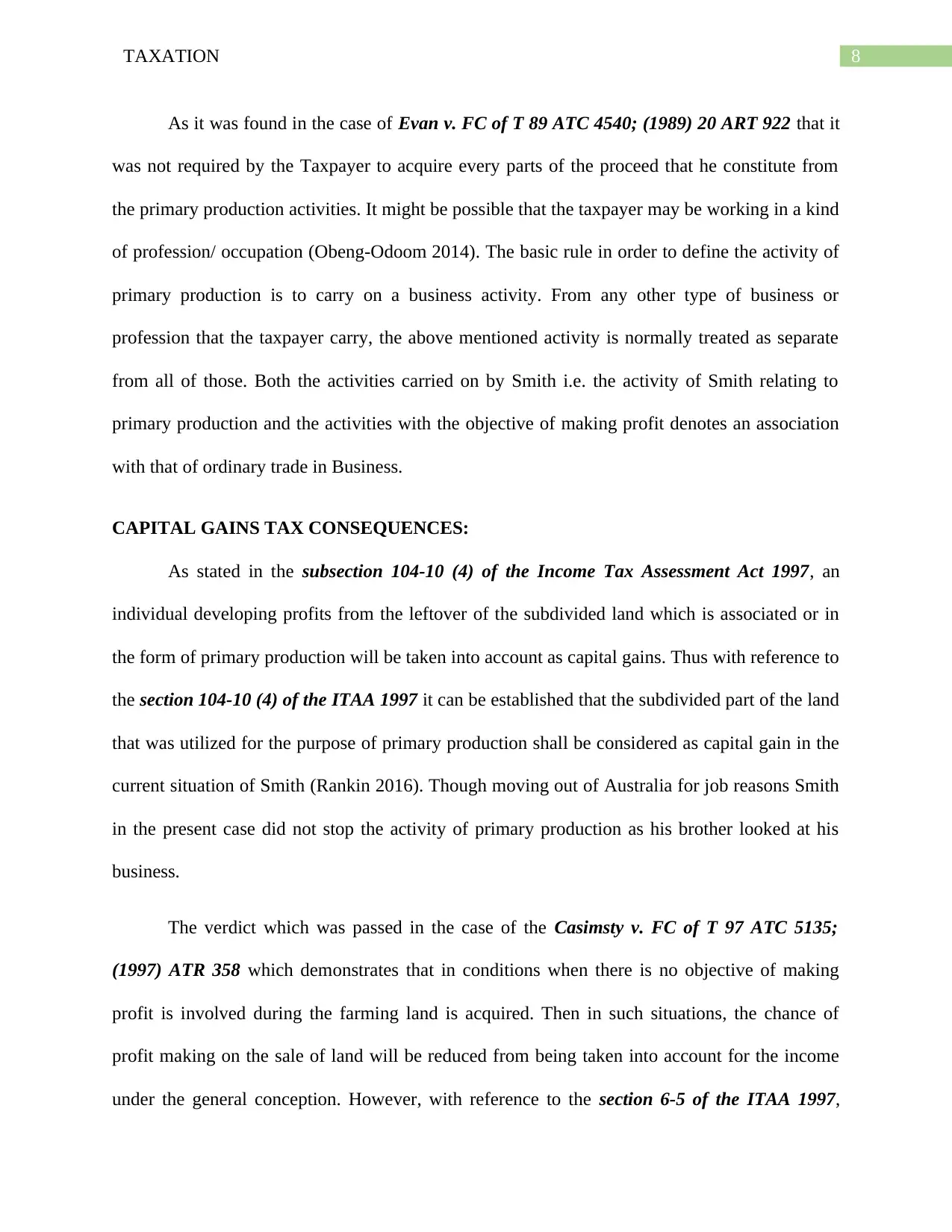
8TAXATION
As it was found in the case of Evan v. FC of T 89 ATC 4540; (1989) 20 ART 922 that it
was not required by the Taxpayer to acquire every parts of the proceed that he constitute from
the primary production activities. It might be possible that the taxpayer may be working in a kind
of profession/ occupation (Obeng-Odoom 2014). The basic rule in order to define the activity of
primary production is to carry on a business activity. From any other type of business or
profession that the taxpayer carry, the above mentioned activity is normally treated as separate
from all of those. Both the activities carried on by Smith i.e. the activity of Smith relating to
primary production and the activities with the objective of making profit denotes an association
with that of ordinary trade in Business.
CAPITAL GAINS TAX CONSEQUENCES:
As stated in the subsection 104-10 (4) of the Income Tax Assessment Act 1997, an
individual developing profits from the leftover of the subdivided land which is associated or in
the form of primary production will be taken into account as capital gains. Thus with reference to
the section 104-10 (4) of the ITAA 1997 it can be established that the subdivided part of the land
that was utilized for the purpose of primary production shall be considered as capital gain in the
current situation of Smith (Rankin 2016). Though moving out of Australia for job reasons Smith
in the present case did not stop the activity of primary production as his brother looked at his
business.
The verdict which was passed in the case of the Casimsty v. FC of T 97 ATC 5135;
(1997) ATR 358 which demonstrates that in conditions when there is no objective of making
profit is involved during the farming land is acquired. Then in such situations, the chance of
profit making on the sale of land will be reduced from being taken into account for the income
under the general conception. However, with reference to the section 6-5 of the ITAA 1997,
As it was found in the case of Evan v. FC of T 89 ATC 4540; (1989) 20 ART 922 that it
was not required by the Taxpayer to acquire every parts of the proceed that he constitute from
the primary production activities. It might be possible that the taxpayer may be working in a kind
of profession/ occupation (Obeng-Odoom 2014). The basic rule in order to define the activity of
primary production is to carry on a business activity. From any other type of business or
profession that the taxpayer carry, the above mentioned activity is normally treated as separate
from all of those. Both the activities carried on by Smith i.e. the activity of Smith relating to
primary production and the activities with the objective of making profit denotes an association
with that of ordinary trade in Business.
CAPITAL GAINS TAX CONSEQUENCES:
As stated in the subsection 104-10 (4) of the Income Tax Assessment Act 1997, an
individual developing profits from the leftover of the subdivided land which is associated or in
the form of primary production will be taken into account as capital gains. Thus with reference to
the section 104-10 (4) of the ITAA 1997 it can be established that the subdivided part of the land
that was utilized for the purpose of primary production shall be considered as capital gain in the
current situation of Smith (Rankin 2016). Though moving out of Australia for job reasons Smith
in the present case did not stop the activity of primary production as his brother looked at his
business.
The verdict which was passed in the case of the Casimsty v. FC of T 97 ATC 5135;
(1997) ATR 358 which demonstrates that in conditions when there is no objective of making
profit is involved during the farming land is acquired. Then in such situations, the chance of
profit making on the sale of land will be reduced from being taken into account for the income
under the general conception. However, with reference to the section 6-5 of the ITAA 1997,
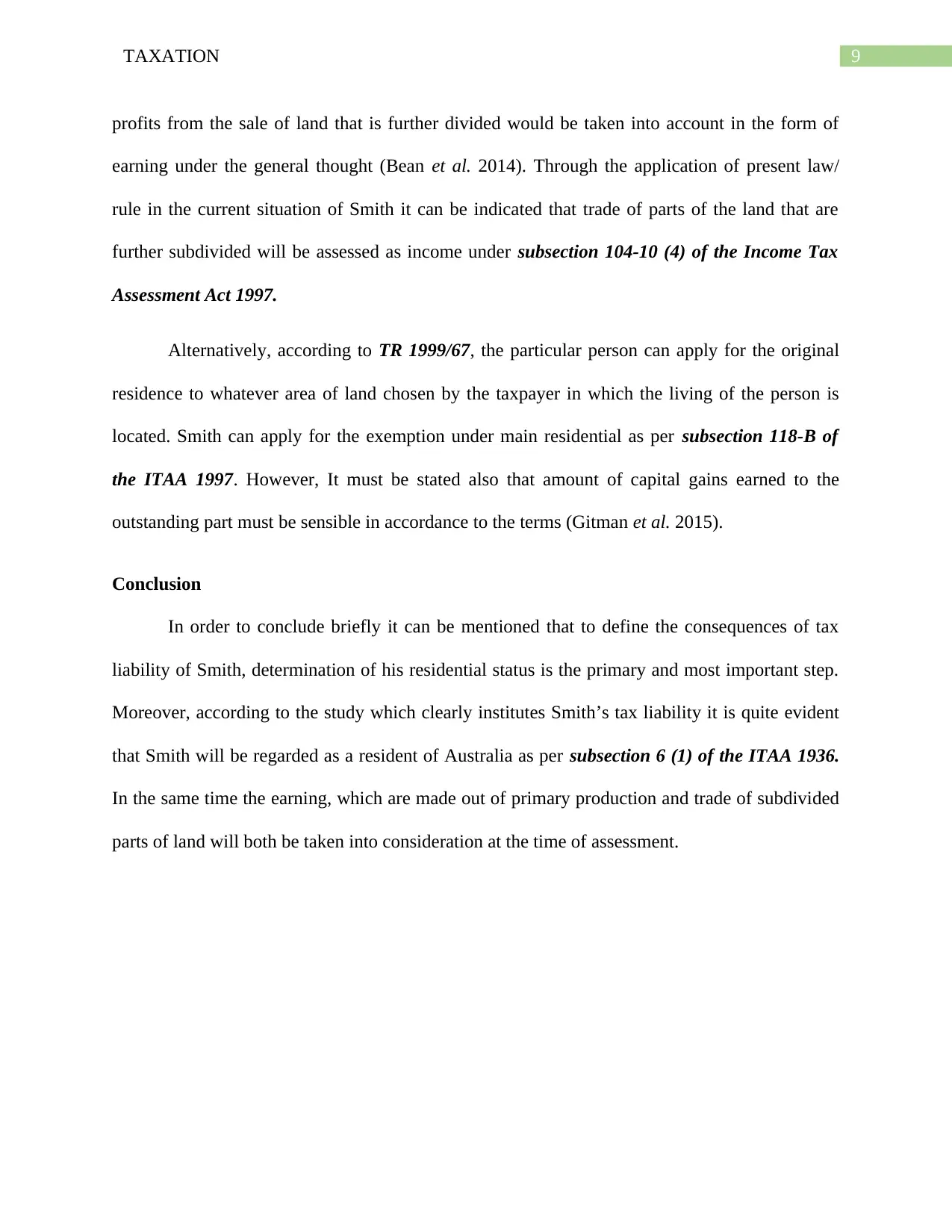
9TAXATION
profits from the sale of land that is further divided would be taken into account in the form of
earning under the general thought (Bean et al. 2014). Through the application of present law/
rule in the current situation of Smith it can be indicated that trade of parts of the land that are
further subdivided will be assessed as income under subsection 104-10 (4) of the Income Tax
Assessment Act 1997.
Alternatively, according to TR 1999/67, the particular person can apply for the original
residence to whatever area of land chosen by the taxpayer in which the living of the person is
located. Smith can apply for the exemption under main residential as per subsection 118-B of
the ITAA 1997. However, It must be stated also that amount of capital gains earned to the
outstanding part must be sensible in accordance to the terms (Gitman et al. 2015).
Conclusion
In order to conclude briefly it can be mentioned that to define the consequences of tax
liability of Smith, determination of his residential status is the primary and most important step.
Moreover, according to the study which clearly institutes Smith’s tax liability it is quite evident
that Smith will be regarded as a resident of Australia as per subsection 6 (1) of the ITAA 1936.
In the same time the earning, which are made out of primary production and trade of subdivided
parts of land will both be taken into consideration at the time of assessment.
profits from the sale of land that is further divided would be taken into account in the form of
earning under the general thought (Bean et al. 2014). Through the application of present law/
rule in the current situation of Smith it can be indicated that trade of parts of the land that are
further subdivided will be assessed as income under subsection 104-10 (4) of the Income Tax
Assessment Act 1997.
Alternatively, according to TR 1999/67, the particular person can apply for the original
residence to whatever area of land chosen by the taxpayer in which the living of the person is
located. Smith can apply for the exemption under main residential as per subsection 118-B of
the ITAA 1997. However, It must be stated also that amount of capital gains earned to the
outstanding part must be sensible in accordance to the terms (Gitman et al. 2015).
Conclusion
In order to conclude briefly it can be mentioned that to define the consequences of tax
liability of Smith, determination of his residential status is the primary and most important step.
Moreover, according to the study which clearly institutes Smith’s tax liability it is quite evident
that Smith will be regarded as a resident of Australia as per subsection 6 (1) of the ITAA 1936.
In the same time the earning, which are made out of primary production and trade of subdivided
parts of land will both be taken into consideration at the time of assessment.
⊘ This is a preview!⊘
Do you want full access?
Subscribe today to unlock all pages.

Trusted by 1+ million students worldwide

10TAXATION
Paraphrase This Document
Need a fresh take? Get an instant paraphrase of this document with our AI Paraphraser
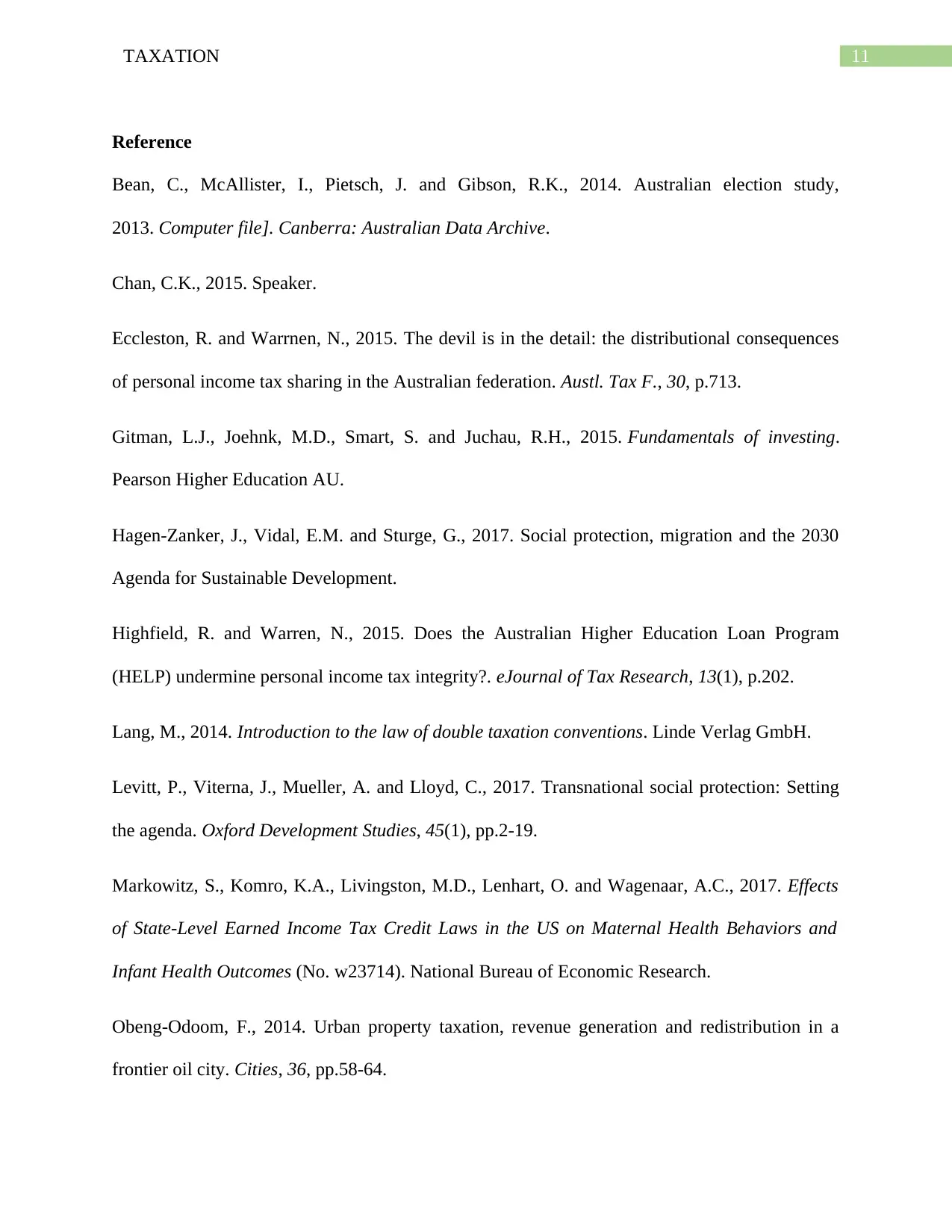
11TAXATION
Reference
Bean, C., McAllister, I., Pietsch, J. and Gibson, R.K., 2014. Australian election study,
2013. Computer file]. Canberra: Australian Data Archive.
Chan, C.K., 2015. Speaker.
Eccleston, R. and Warrnen, N., 2015. The devil is in the detail: the distributional consequences
of personal income tax sharing in the Australian federation. Austl. Tax F., 30, p.713.
Gitman, L.J., Joehnk, M.D., Smart, S. and Juchau, R.H., 2015. Fundamentals of investing.
Pearson Higher Education AU.
Hagen-Zanker, J., Vidal, E.M. and Sturge, G., 2017. Social protection, migration and the 2030
Agenda for Sustainable Development.
Highfield, R. and Warren, N., 2015. Does the Australian Higher Education Loan Program
(HELP) undermine personal income tax integrity?. eJournal of Tax Research, 13(1), p.202.
Lang, M., 2014. Introduction to the law of double taxation conventions. Linde Verlag GmbH.
Levitt, P., Viterna, J., Mueller, A. and Lloyd, C., 2017. Transnational social protection: Setting
the agenda. Oxford Development Studies, 45(1), pp.2-19.
Markowitz, S., Komro, K.A., Livingston, M.D., Lenhart, O. and Wagenaar, A.C., 2017. Effects
of State-Level Earned Income Tax Credit Laws in the US on Maternal Health Behaviors and
Infant Health Outcomes (No. w23714). National Bureau of Economic Research.
Obeng-Odoom, F., 2014. Urban property taxation, revenue generation and redistribution in a
frontier oil city. Cities, 36, pp.58-64.
Reference
Bean, C., McAllister, I., Pietsch, J. and Gibson, R.K., 2014. Australian election study,
2013. Computer file]. Canberra: Australian Data Archive.
Chan, C.K., 2015. Speaker.
Eccleston, R. and Warrnen, N., 2015. The devil is in the detail: the distributional consequences
of personal income tax sharing in the Australian federation. Austl. Tax F., 30, p.713.
Gitman, L.J., Joehnk, M.D., Smart, S. and Juchau, R.H., 2015. Fundamentals of investing.
Pearson Higher Education AU.
Hagen-Zanker, J., Vidal, E.M. and Sturge, G., 2017. Social protection, migration and the 2030
Agenda for Sustainable Development.
Highfield, R. and Warren, N., 2015. Does the Australian Higher Education Loan Program
(HELP) undermine personal income tax integrity?. eJournal of Tax Research, 13(1), p.202.
Lang, M., 2014. Introduction to the law of double taxation conventions. Linde Verlag GmbH.
Levitt, P., Viterna, J., Mueller, A. and Lloyd, C., 2017. Transnational social protection: Setting
the agenda. Oxford Development Studies, 45(1), pp.2-19.
Markowitz, S., Komro, K.A., Livingston, M.D., Lenhart, O. and Wagenaar, A.C., 2017. Effects
of State-Level Earned Income Tax Credit Laws in the US on Maternal Health Behaviors and
Infant Health Outcomes (No. w23714). National Bureau of Economic Research.
Obeng-Odoom, F., 2014. Urban property taxation, revenue generation and redistribution in a
frontier oil city. Cities, 36, pp.58-64.
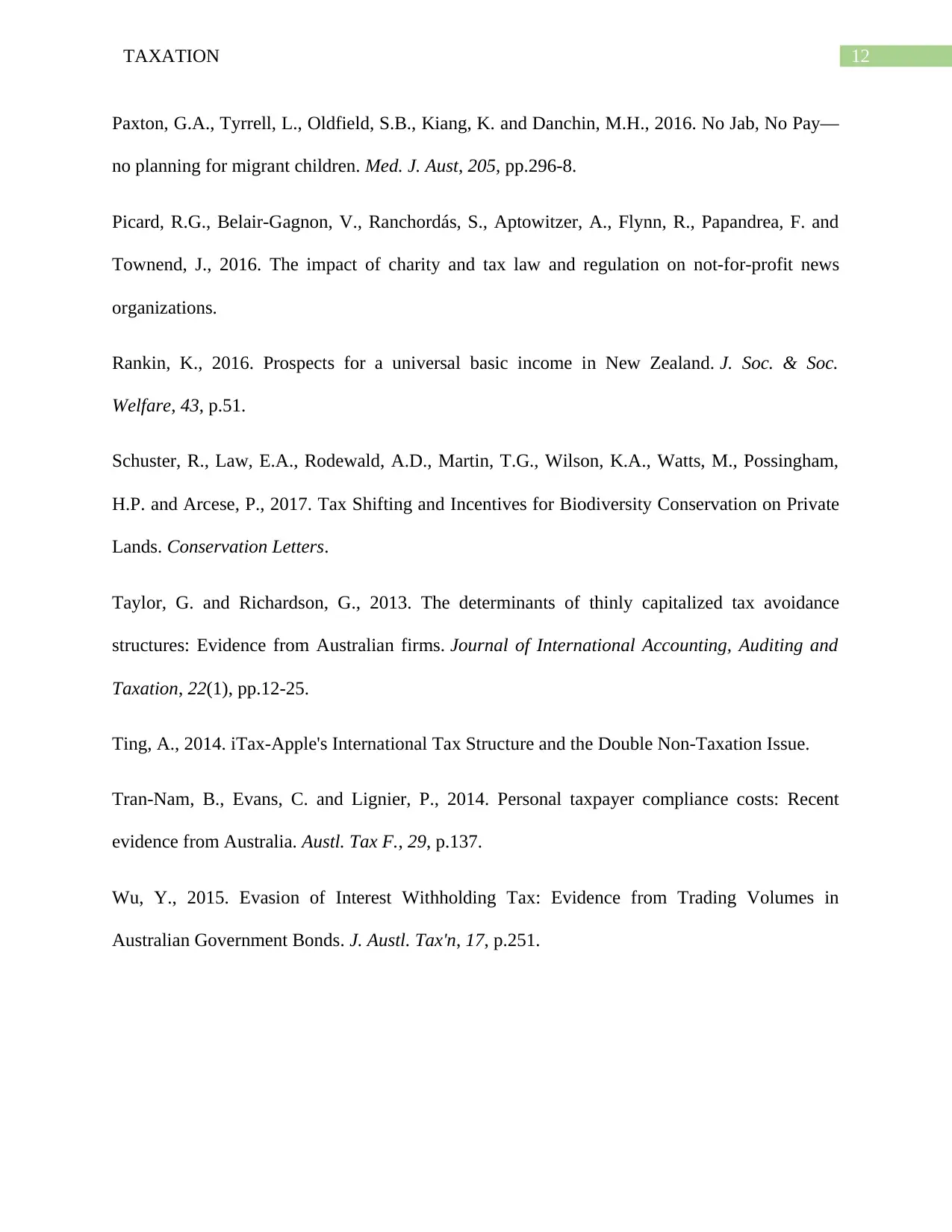
12TAXATION
Paxton, G.A., Tyrrell, L., Oldfield, S.B., Kiang, K. and Danchin, M.H., 2016. No Jab, No Pay—
no planning for migrant children. Med. J. Aust, 205, pp.296-8.
Picard, R.G., Belair-Gagnon, V., Ranchordás, S., Aptowitzer, A., Flynn, R., Papandrea, F. and
Townend, J., 2016. The impact of charity and tax law and regulation on not-for-profit news
organizations.
Rankin, K., 2016. Prospects for a universal basic income in New Zealand. J. Soc. & Soc.
Welfare, 43, p.51.
Schuster, R., Law, E.A., Rodewald, A.D., Martin, T.G., Wilson, K.A., Watts, M., Possingham,
H.P. and Arcese, P., 2017. Tax Shifting and Incentives for Biodiversity Conservation on Private
Lands. Conservation Letters.
Taylor, G. and Richardson, G., 2013. The determinants of thinly capitalized tax avoidance
structures: Evidence from Australian firms. Journal of International Accounting, Auditing and
Taxation, 22(1), pp.12-25.
Ting, A., 2014. iTax-Apple's International Tax Structure and the Double Non-Taxation Issue.
Tran-Nam, B., Evans, C. and Lignier, P., 2014. Personal taxpayer compliance costs: Recent
evidence from Australia. Austl. Tax F., 29, p.137.
Wu, Y., 2015. Evasion of Interest Withholding Tax: Evidence from Trading Volumes in
Australian Government Bonds. J. Austl. Tax'n, 17, p.251.
Paxton, G.A., Tyrrell, L., Oldfield, S.B., Kiang, K. and Danchin, M.H., 2016. No Jab, No Pay—
no planning for migrant children. Med. J. Aust, 205, pp.296-8.
Picard, R.G., Belair-Gagnon, V., Ranchordás, S., Aptowitzer, A., Flynn, R., Papandrea, F. and
Townend, J., 2016. The impact of charity and tax law and regulation on not-for-profit news
organizations.
Rankin, K., 2016. Prospects for a universal basic income in New Zealand. J. Soc. & Soc.
Welfare, 43, p.51.
Schuster, R., Law, E.A., Rodewald, A.D., Martin, T.G., Wilson, K.A., Watts, M., Possingham,
H.P. and Arcese, P., 2017. Tax Shifting and Incentives for Biodiversity Conservation on Private
Lands. Conservation Letters.
Taylor, G. and Richardson, G., 2013. The determinants of thinly capitalized tax avoidance
structures: Evidence from Australian firms. Journal of International Accounting, Auditing and
Taxation, 22(1), pp.12-25.
Ting, A., 2014. iTax-Apple's International Tax Structure and the Double Non-Taxation Issue.
Tran-Nam, B., Evans, C. and Lignier, P., 2014. Personal taxpayer compliance costs: Recent
evidence from Australia. Austl. Tax F., 29, p.137.
Wu, Y., 2015. Evasion of Interest Withholding Tax: Evidence from Trading Volumes in
Australian Government Bonds. J. Austl. Tax'n, 17, p.251.
⊘ This is a preview!⊘
Do you want full access?
Subscribe today to unlock all pages.

Trusted by 1+ million students worldwide
1 out of 12
Related Documents
Your All-in-One AI-Powered Toolkit for Academic Success.
+13062052269
info@desklib.com
Available 24*7 on WhatsApp / Email
![[object Object]](/_next/static/media/star-bottom.7253800d.svg)
Unlock your academic potential
Copyright © 2020–2025 A2Z Services. All Rights Reserved. Developed and managed by ZUCOL.





